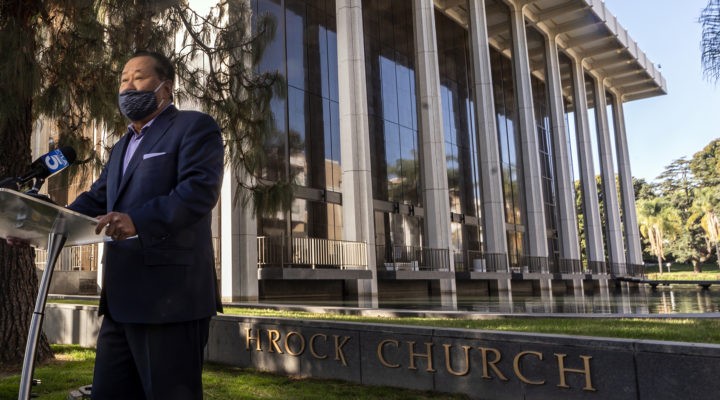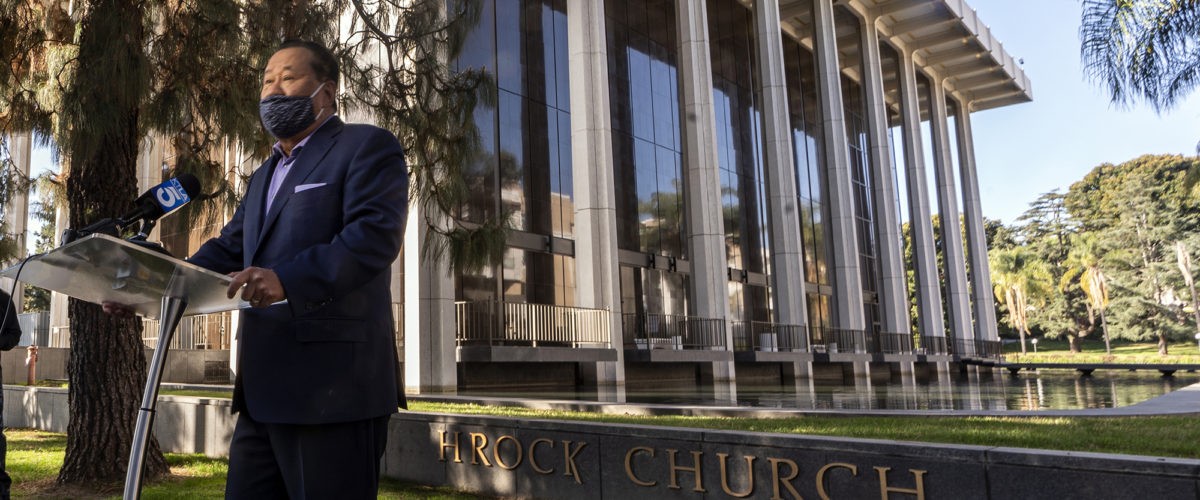In a sign of how long the coronavirus pandemic has gone on, the United States Supreme Court has been dealt enough cases on church closures during the pandemic now to have reversed itself and splintered further in its own opinions. Seldom has an issue come before the court so frequently during such a relatively short period of time.
A 6-3 ruling issued late Friday, Feb. 5, regarding California churches and public health restrictions on indoor worship was the sixth time the high court has interacted with COVID church restrictions since May 2020.
In the latest case, the court’s new conservative majority sided solidly — but with various rationales — with evangelical churches in California that believe Gov. Gavin Newsom has singled out houses of worship for stricter regulation than other similar businesses.
What’s similar to houses of worship?
As before, the case continues to turn on what constitutes a “similar” business to a church. The state’s original multi-tiered structure for required closures and modifications treated churches the same as movie theaters, indoor live-sports venues and other large indoor assemblies where participants are seated.
Some pastors and church leaders protested that churches should not be treated more harshly than nail salons, retail shops and outdoor protests and marches.
One of the new majority opinions written by Justice Neil Gorsuch and joined by Justices Clarence Thomas and Thomas Alito — usually the most conservative side of the court — declared that “California is the only state in the country that has gone so far as to ban all indoor religious services.”
“California is the only state in the country that has gone so far as to ban all indoor religious services.”
Gorsuch explained: “Since the arrival of COVID–19, California has openly imposed more stringent regulations on religious institutions than on many businesses. The state’s spreadsheet summarizing its pandemic rules even assigns places of worship their own row. … Meanwhile, the state allows most retail operations to proceed indoors with 25% occupancy, and other businesses to operate at 50% occupancy or more.”
Chief Justice John Roberts, who wrote the lead majority opinion in this case, offered a more nuanced interpretation: “The state’s present determination — that the maximum number of adherents who can safely worship in the most cavernous cathedral is zero — appears to reflect not expertise or discretion, but instead insufficient appreciation or consideration of the interests at stake.”
Justice Elena Kagan, joined by fellow Justices Sonia Sotomayor and Stephen Breyer — representing the traditional left side of the court — dissented from the majority ruling in a six-page opinion. She took aim at her fellow justices in the majority for usurping the advice of medical professionals in California: “Justices of this court are not scientists. Nor do we know much about public health policy. Yet today the court displaces the judgments of experts about how to respond to a raging pandemic.”
“Justices of this court are not scientists. Nor do we know much about public health policy.”
“Under the court’s injunction,” she wrote, California must “treat worship services like secular activities that pose a much lesser danger. That mandate defies our caselaw, exceeds our judicial role, and risks worsening the pandemic.”
California’s original policies “treat worship just as favorably as secular activities (including political assemblies) that, according to medical evidence, pose the same risk of COVID transmission. Under the court’s injunction, the State must instead treat worship services like secular activities that pose a much lesser danger. That mandate defies our caselaw, exceeds our judicial role, and risks worsening the pandemic,” she added.
Kagan argued that the original California policies satisfied the law’s required neutrality toward religion before imposing any restrictions. The state has shown neutrality “by regulating worship services the same as other activities ‘where large groups of people (come together) in close proximity for extended periods of time,” she wrote, quoting a previous opinion of Chief Justice Roberts.
Similarly restricted activities in California include “attending a worship service or political meeting; going to a lecture, movie, play, or concert; and frequenting a restaurant, winery, or bar. So the activities are both religious and secular — and many of the secular gatherings, too, are constitutionally protected.”
In short, she wrote, “the state has put limits on how many people can assemble in one indoor space — whether a church, theater or lecture hall.”
This latest ruling was in response to a case brought by Pasadena-based Harvest Rock Church and Harvest International Ministry, which has more than 160 sites across the state.
The LA Daily News reported that the multi-site church has defied state orders since last May by holding service indoors. The newspaper quoted Pastor Art Hodges telling Californians after the Friday ruling: “You can go to your house of worship, as of now! You can go back to church; we’re excited about that.”
Revised California policies
Two days after the high court ruling, Gov. Newsom issued revised public health orders that continue with the state’s multi-tier approach based on current spread of the virus in each county of state. Under the revised rules, counties in the purple and red tiers may allow churches to open for indoor services with a maximum capacity of 25%. Counties in the orange and yellow tier will be allowed to open for indoor services at 50% capacity.
The revised regulations sparked by the Supreme Court decision now give houses of worship in California more latitude for indoor gatherings than restaurants, bars, movie theaters, gyms or live-audience sports.
The revised regulations sparked by the Supreme Court decision now give houses of worship in California more latitude for indoor gatherings than restaurants, bars, movie theaters, gyms or live-audience sports.
A partial victory
The suing California churches won a partial victory in this case — still facing percentage occupancy limits and still facing a total ban on indoor singing and chanting. The matter of allowing singing divided the justices ruling in the majority, with Justices Thomas, Gorsuch and Alito saying they would have preferred to lift the ban on singing and chanting.
Justice Amy Coney Barrett filed a separate opinion with the majority that was joined by Justice Brett Kavanaugh. She argued it is the churches’ responsibility to demonstrate they are entitled to relief from the ban on singing, but they had not done so. Several justices noted in their opinions that there is confusion in the state about how broadly the ban on singing applies and whether Hollywood studios, for example, are being held to a different standard than churches.
History of previous rulings
Among all states, California has been at the forefront of litigation about religious worship and COVID restrictions.
Early in the pandemic, the Supreme Court declined to intervene in a California church’s challenge to the state’s public health restrictions. That May ruling from the court was a 5-4 decision with the late Justice Ruth Bader Ginsburg still alive and voting in the majority to allow California’s governor to restrict attendance at houses of worship in order to control the spread of coronavirus.
Below is a brief summary, in reverse chronological order, of the instances over the past year where the Supreme Court has dealt with COVID and churches. Numerous other cases have been filed in lower courts during the same period.
- On Jan. 25, the Supreme Court denied the petition of Calvary Chapel in Dayton Valley, Nev., to “clarify that houses of worship and comparable secular entities should be treated equally during the coronavirus pandemic.”
- On Dec. 3, the Supreme Court agreed with Harvest Rock Church in Pasadena, Calif., that a 9th U.S. Circuit Court of Appeals ruling favoring Newsom’s restrictions should be set aside.
- On Nov. 26, the Supreme Court blocked New York’s restrictions on attendance at religious worship services in certain zones to contain the spread of COVID.
- On Nov. 16, Justice Samuel Alito gave a speech in which he declared many state restrictions related to the pandemic are overreaching and infringe on First Amendment freedoms. “The pandemic has resulted in previously unimaginable restrictions on individual liberty,” he told the Federalist Society. “It is an indisputable statement of fact, we have never before seen restrictions as severe, extensive and prolonged as those experienced for most of 2020.”
- On July 27, the Supreme Court denied the original request of Calvary Chapel of Dayton Valley, Nev., to strike down a 50-person limit on worship services.
- On May 29, the Supreme Court denied the request of South Bay United Pentecostal Church and Bishop Arthur Hodges to overrule California’s restrictions on indoor worship due to COVID. This was the first case related to house of worship and COVID to reach the high court.
Related articles:
What does the Supreme Court’s midnight COVID ruling really mean for religious liberty?
As COVID cases soar, court’s retreat opens doors of churches
Noah had a quick trip compared to John MacArthur’s battle with Los Angeles County
How John MacArthur loves the Bible but not his neighbor
John MacArthur retains Trump lawyer in fight over COVID restrictions


